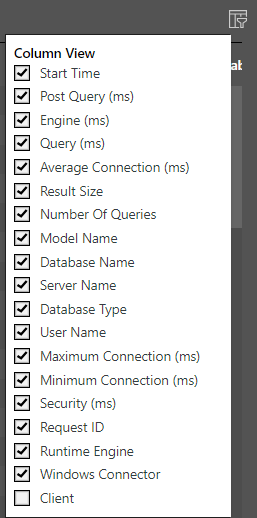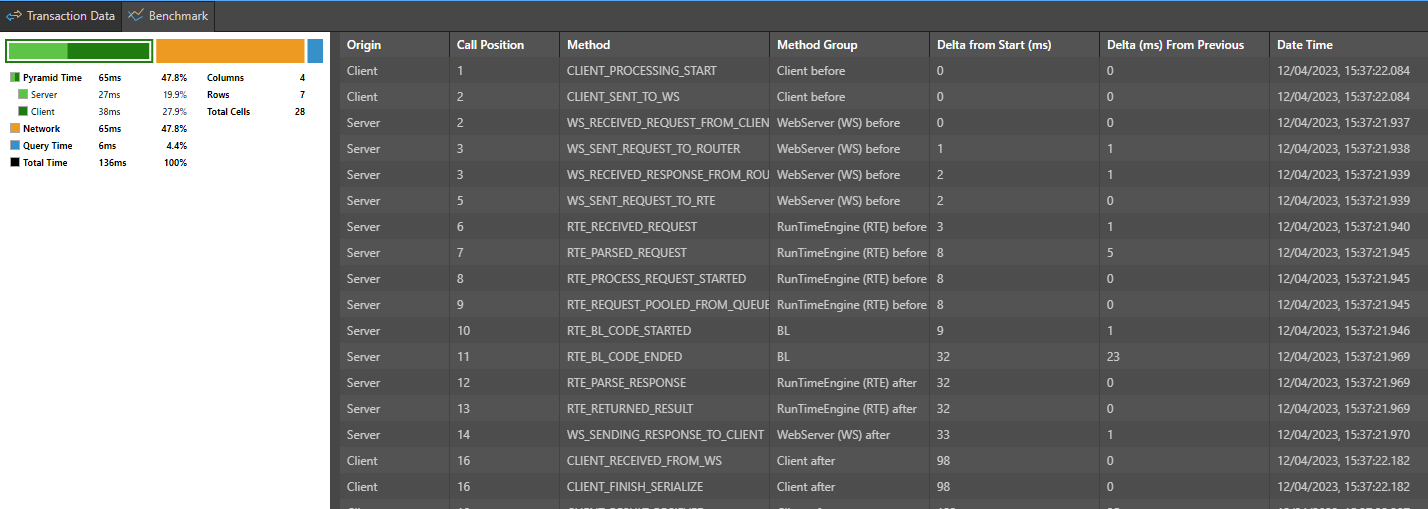Transaction logging provides a list of all transactional queries run by users in the analytics tools against data sources. The transaction logs do NOT include any queries run against the repository.
Transaction logging is enabled by default. To change the log settings, go to Logs > Log Settings.
Benchmark Log
If enabled, the transaction log viewer will also show a deeper analysis of query performance known as the Benchmark Log.
Note: The Benchmark is disabled by default. To enable this feature, go to Logs > Log Settings.
Warning: Benchmark logging can significantly slow the performance of the platform. It should be turned on for diagnostics only and then turned off.
Transaction Log Details
The transaction log page is broken into two panels.
Top Panel

Filter by Last
Include only those events that were logged within a selected time period (red box, above)
- Select a <time period> to include events logged between now and that selected time (between 1 minute and 12 months ago).
- Select All to include events logged at any time.
- Select Custom to include events within a custom period. Start and End Date fields let you supply the details of your custom time period.
Start Time Filter
The Start Time Filter (blue box above) allows users to show rows equal to, before, after, or between selected date and time values
Clear Logs
Selecting the clear logs button (green box above) will 'purge' (permanently delete) all of the logs of this type. Removes the logs from the displayed transaction logs.
Export
Selecting the export button will download a CSV file detailing all the logs displayed.
Displayed Columns
The panel displays high level stats on the transaction and query.
- Start Time: The start time for the query.
- Post Query: The time Pyramid spent processing the query result in milliseconds.
- Engine: The total time needed to submit the query and process it before returning it to the client (Connection + Query + Post) in milliseconds.
- Query: The Query time in milliseconds, which includes:
- Execution Time: The time it takes for the data source to execute and return the query.
- Read Time: The time required to read the results (both result size and network performance are factors).
- Acquire Connection Time: The time it takes to establish the connection.
- Average Connection: The time it took to establish a connection in milliseconds.
- Result size: The number of cells (rows x columns) in the query result.
- Number of Queries: The total number of queries run.
Additional columns display details of the query
- Model Name
- Database Name
- Server Name
- Database Type
- User Name
- Maximum Connection
- Minimum Connection
- Security
- Request ID
- Runtime Engine
- Windows Connector
- Client
Column View
The Column View (yellow box above) allows users to select the required columns they want to see.

Sort and Filter
Most column headers include options to sort and filter the results:
- Hover over a column header to Sort the results by ascending or descending order.
- Hover over a column heading to open the Filter options. Filtering allows you to limit the results shown in the column by value. Click the filter icon associated with your column, specify the details of your filter, and click Apply. Which details you see depends on the data type of the value in the selected column:
- If the column contains a Date / time you can select from the options:
- Equals - Return logs with the selected date and time.
- Before - Return logs up to the selected date and time.
- After - Return logs after the selected date and time.
- Between - Return logs within a particular date and time window. In this case, you need to specify the start and end date for your filter.
- If the column contains a Number you can select from the options: Equals, Not Equals, Greater than, Greater than or Equals, Less than, Less than or equals, and specify a comparison value.
- If the column contains a String you can select from the options: Equals, Does Not Equal, Start with, End with, Contain, Does not contain, and specify a comparison value.
Pagination

Where there are more results than fit on a single page, a set of pagination controls opens underneath the table of results. You can use these controls to:
- See how many pages of results there are.
- Move between the pages of results.
- Go directly to a specific page of results.
Bottom Panel
The bottom panel is broken into two sections: basic transactional details and the more advanced benchmark details. Double-click a row in the top panel to open the message associated with that logged event in the bottom panel.
Transaction Data
The transaction panel displays more details for the selected transaction log in 3 sections.
- Detailed information in a portrait landscape (red box)
- The raw SQL or MDX query run against the data source (green box)
- A breakdown of how each component of the query performed (blue box).
Previous and Next Log
Users can traverse to view the details of the previous or next log by clicking on the previous and next buttons (yellow box)

Benchmark
The benchmark logs are an extension of the transaction logs - providing deeper analysis of the query transactions for optimization purposes. The panel shows specifics for any selected transaction, showing each stage in the query pipeline. This will not be available if benchmark logging is disabled.

- The graphic on the left is used to summarize the times and give a bird's eye view of the pipeline. It is very useful in diagnosing performance issues and separating out Pyramid processing from database processing from network latency.
- Pyramid Time represents the time allotted to Pyramid processing on the server (pre and post) and the Pyramid web client
- Network represents the time taken to send and receive data across the network between the client and server
- Query Time represents the time taken to connect to a data source, submit the request, for the data source to process the request and return a response to Pyramid.
- The rows and columns provide metrics on the size of the result.
- The grid on the right highlights each stage and the time taken to resolve each element in the pipeline from client to server, to database and back to client.
It is beyond the scope of this help article to explain each item. These details are for Pyramid engineers when trying to diagnose performance issues for a customer.
If benchmark logging is enabled, the benchmark summary graphic is also available from the App Tabs in Discover. For more information, see Performance dialog in Discover.